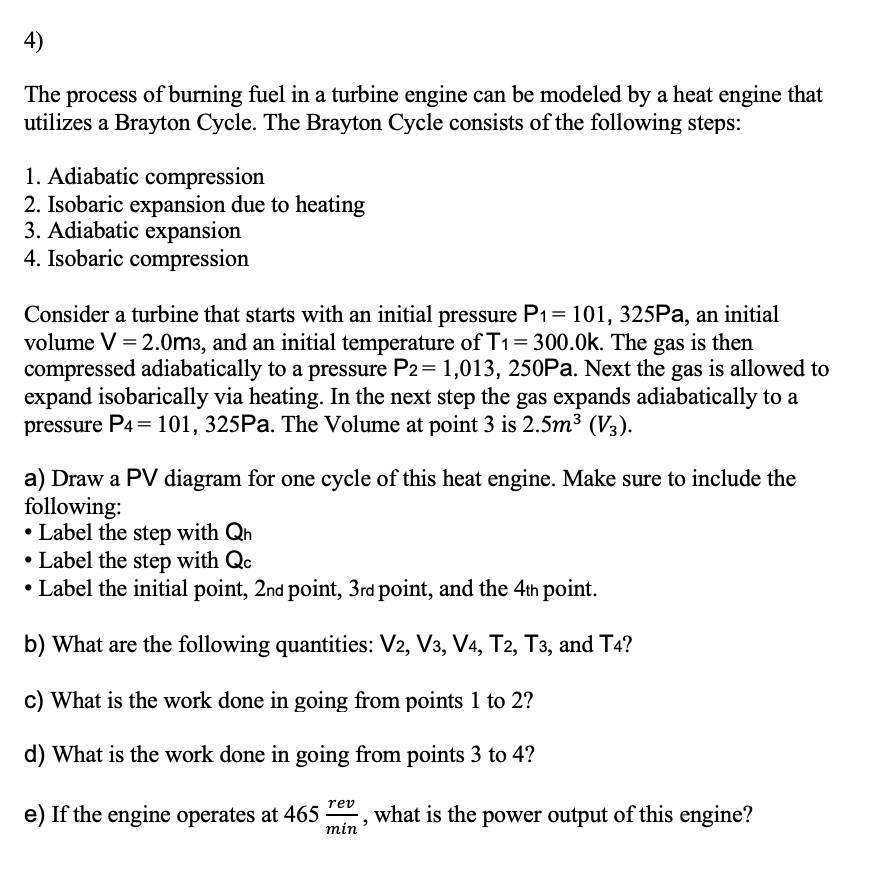4) The process of burning fuel in a turbine engine can be modeled by a heat engine that utilizes a Brayton Cycle. The Brayton Cycle consists of the following steps: 1. Adiabatic compression 2. Isobaric expansion due to heating 3. Adiabatic expansion 4. Isobaric compression Consider a turbine that starts with an initial pressure P1= 101, 325PA, an initial volume V = 2.0m3, and an initial temperature of T1= 300.0k. The gas is then compressed adiabatically to a pressure P2= 1,013, 250PA. Next the gas is allowed to expand isobarically via heating. In the next step the gas expands adiabatically to a pressure P4 = 101, 325Pa. The Volume at point 3 is 2.5m³ (V3). a) Draw a PV diagram for one cycle of this heat engine. Make sure to include the following: • Label the step with Qh • Label the step with Qc • Label the initial point, 2nd point, 3rd point, and the 4th point. b) What are the following quantities: V2, V3, V4, T2, T3, and T4? c) What is the work done in going from points 1 to 2? d) What is the work done in going from points 3 to 4? rev e) If the engine operates at 465 what is the power output of this engine? min
4) The process of burning fuel in a turbine engine can be modeled by a heat engine that utilizes a Brayton Cycle. The Brayton Cycle consists of the following steps: 1. Adiabatic compression 2. Isobaric expansion due to heating 3. Adiabatic expansion 4. Isobaric compression Consider a turbine that starts with an initial pressure P1= 101, 325PA, an initial volume V = 2.0m3, and an initial temperature of T1= 300.0k. The gas is then compressed adiabatically to a pressure P2= 1,013, 250PA. Next the gas is allowed to expand isobarically via heating. In the next step the gas expands adiabatically to a pressure P4 = 101, 325Pa. The Volume at point 3 is 2.5m³ (V3). a) Draw a PV diagram for one cycle of this heat engine. Make sure to include the following: • Label the step with Qh • Label the step with Qc • Label the initial point, 2nd point, 3rd point, and the 4th point. b) What are the following quantities: V2, V3, V4, T2, T3, and T4? c) What is the work done in going from points 1 to 2? d) What is the work done in going from points 3 to 4? rev e) If the engine operates at 465 what is the power output of this engine? min
Elements Of Electromagnetics
7th Edition
ISBN:9780190698614
Author:Sadiku, Matthew N. O.
Publisher:Sadiku, Matthew N. O.
ChapterMA: Math Assessment
Section: Chapter Questions
Problem 1.1MA
Related questions
Question
Answer Questions B) C) D)

Transcribed Image Text:4)
The process of burning fuel in a turbine engine can be modeled by a heat engine that
utilizes a Brayton Cycle. The Brayton Cycle consists of the following steps:
1. Adiabatic compression
2. Isobaric expansion due to heating
3. Adiabatic expansion
4. Isobaric compression
Consider a turbine that starts with an initial pressure P1= 101, 325PA, an initial
volume V = 2.0m3, and an initial temperature of T1= 300.0k. The gas is then
compressed adiabatically to a pressure P2= 1,013, 250PA. Next the gas is allowed to
expand isobarically via heating. In the next step the gas expands adiabatically to a
pressure P4 = 101, 325Pa. The Volume at point 3 is 2.5m³ (V3).
a) Draw a PV diagram for one cycle of this heat engine. Make sure to include the
following:
• Label the step with Qh
• Label the step with Qc
• Label the initial point, 2nd point, 3rd point, and the 4th point.
b) What are the following quantities: V2, V3, V4, T2, T3, and T4?
c) What is the work done in going from points 1 to 2?
d) What is the work done in going from points 3 to 4?
rev
e) If the engine operates at 465
what is the power output of this engine?
min
Expert Solution
This question has been solved!
Explore an expertly crafted, step-by-step solution for a thorough understanding of key concepts.
This is a popular solution!
Trending now
This is a popular solution!
Step by step
Solved in 4 steps with 4 images

Knowledge Booster
Learn more about
Need a deep-dive on the concept behind this application? Look no further. Learn more about this topic, mechanical-engineering and related others by exploring similar questions and additional content below.Recommended textbooks for you

Elements Of Electromagnetics
Mechanical Engineering
ISBN:
9780190698614
Author:
Sadiku, Matthew N. O.
Publisher:
Oxford University Press

Mechanics of Materials (10th Edition)
Mechanical Engineering
ISBN:
9780134319650
Author:
Russell C. Hibbeler
Publisher:
PEARSON

Thermodynamics: An Engineering Approach
Mechanical Engineering
ISBN:
9781259822674
Author:
Yunus A. Cengel Dr., Michael A. Boles
Publisher:
McGraw-Hill Education

Elements Of Electromagnetics
Mechanical Engineering
ISBN:
9780190698614
Author:
Sadiku, Matthew N. O.
Publisher:
Oxford University Press

Mechanics of Materials (10th Edition)
Mechanical Engineering
ISBN:
9780134319650
Author:
Russell C. Hibbeler
Publisher:
PEARSON

Thermodynamics: An Engineering Approach
Mechanical Engineering
ISBN:
9781259822674
Author:
Yunus A. Cengel Dr., Michael A. Boles
Publisher:
McGraw-Hill Education

Control Systems Engineering
Mechanical Engineering
ISBN:
9781118170519
Author:
Norman S. Nise
Publisher:
WILEY

Mechanics of Materials (MindTap Course List)
Mechanical Engineering
ISBN:
9781337093347
Author:
Barry J. Goodno, James M. Gere
Publisher:
Cengage Learning

Engineering Mechanics: Statics
Mechanical Engineering
ISBN:
9781118807330
Author:
James L. Meriam, L. G. Kraige, J. N. Bolton
Publisher:
WILEY